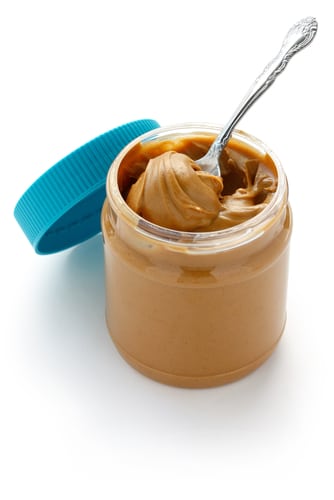
There are other problems with low-fat products – they usually loaded with added sweeteners. Low-fat versions of many packaged products contain added sugar or corn syrup that can send your insulin levels soaring and make it easier for your body to store fat. You can avoid this problem by limiting the number of packaged foods you eat. When you do buy something packaged, be sure to choose the full-fat version of these products.
Full-Fat: Peanut Butter
Reduced-fat peanut butter sounds like a good way to save some calories. Low-fat peanut butter may be lower in calories than regular peanut butter, but full-fat is still the better choice. Low-fat versions usually have lots of added sugar to make up for the fat it lacks. Plus, the fat in peanut butter is mostly heart-healthy monounsaturated fat, the kind that helps to lower cholesterol levels. In addition, research shows people who eat nuts enjoy a lower risk of heart disease. For added health benefits, choose almond butter over peanut butter. It has more vitamin E and a greater percentage of healthy fats than peanut butter.
Full-Fat: Yogurt
Low-fat yogurts are a popular item at the grocery store but you’re better off reaching for the full-fat kind instead. Low-fat yogurt is often loaded with sweeteners and starches and things you don’t need like modified corn starch. It’s not a good trade-off. Look for plain, full-fat Greek yogurt instead. It has almost twice the protein and fewer carbs. Greek yogurt is usually lower in sodium too. You can always add berries for a touch of natural sweetness. Stay away from flavored yogurts too. Many have synthetic flavors and colorings.
Full-Fat: Cheese
Yes, full-fat cheese is high in fat and calories but you only need a small amount to feel satisfied, especially if you choose one with a strong flavor. It’s a better choice than low-fat and fat-free packaged cheeses that contain added sweeteners like corn syrup and artificial colorings and flavorings. Yuck! Stick with unprocessed full-fat cheese and eat less of it. Who needs synthetic additives?
Full-Fat: Salad Dressing
Salad dressings are another source of “hidden” sugar, especially when you choose low-fat and fat-free salad dressing in a bottle. When you read the ingredient list, don’t be surprised to find corn syrup or high-fructose corn syrup listed as an ingredient. You need some fat in your salad dressing to help absorb fat-soluble vitamins like vitamins A, D, E and K from the veggies you’re eating. The best option is to skip the bottled dressings entirely and make your own with olive oil and balsamic vinegar. If you buy a packaged salad dressing, look for one that’s olive oil-based, has a short ingredient list and is as low in sugar as possible.
Full-Fat: Egg Beaters
Egg Beaters may sound like a good option since they’re lower in calories but when you substitute Egg Beaters for whole eggs, you won’t get the benefits of the choline that’s only in the yolk of the egg. Choline is a compound related to the B vitamins that have anti-inflammatory benefits and may be beneficial for your brain. The yolk is also a good source of two antioxidants called lutein and zeaxanthin that are important for eye health. If you want to lower the calorie content, mix Egg Beaters half and half with whole Eggland’s Best eggs, but don’t miss out on the benefits the yolk offers.
The Bottom Line?
Stick with unprocessed foods as much as possible. When you do buy something packaged, don’t fall into the low-fat trap, especially when it comes to these five items. It’s not worth getting the extra sugar and additives just to save a few calories.
Related Articles By Cathe:
Can Low-Fat Processed Foods Be Worse For Your Health Than The Regular Versions?
Why are Processed Foods So Hard to Give Up?
Healthy Food Changes: Makes These Switches for Greater Nutritional Benefits
4 Reasons Why Low-Fat Diets Aren’t Best for Weight Loss
Why Eating Low-Calorie Foods Won’t Necessarily Help You Lose Weight

